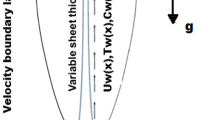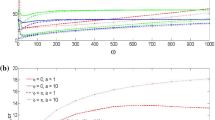Abstract
This paper presents a modal and non-modal stability analysis of the boundary layer developed on a hot plate. A liquid-type temperature-dependent viscosity model has been considered to account for the viscosity variation in the boundary layer region. The base flow is uniform and parallel to the surface at the leading edge. The base flow solution is obtained using an open-source finite volume source code. The Reynolds number (Re) is defined based on the displacement thickness (δ*) at the inlet of the computation domain. The spectral collocation method is used for spatial discretization of governing stability equations. The formulated generalized eigenvalue problem (EVP) is solved using Arnoldi’s iterative algorithm with the shift and invert strategy. The global temporal eigenmodes are calculated for the sensitivity parameter β from 1 to 7, Re = 135, 270, and 405, and the span wise wave-number N from 0 to 1. The modal and non-modal stability analysis have been performed to study the least stable eigenmodes and the optimal initial conditions and perturbations (using mode superposition), respectively. The global temporal eigenmodes are found more stable for β > 0 at a given value of N. Thus, heating the boundary layer within the considered range of β (0 < β ≤ 7) leads to the stabilization of flow. The optimal energy growth increases with the β due to reducing the perturbation energy loss. Tilted elongated structures of the optimal perturbations are found near the outflow boundary. However, the length scale of the elongated cellular mode structure reduces with increase in β. The same qualitative structure of the optimal perturbations has been found at a given value of N.

















Similar content being viewed by others
REFERENCES
Tollmien, W., Über die Entstehung der Turbullenz. 1. Mitteilung, Nachr. Ges. Wiss. Goettingen, Math.-Phys. Kl., 1929, vol. 1929, pp. 21–44.
Schlichting, H., Laminare strahlausbreitung, Z. Angew. Math. Mech., 1933, vol. 13, no. 4, pp. 260–263.
Schubauer, G.B. and Skramstad, H.K., Laminar boundary-layer oscillations and stability of laminar flow, J. Aeronaut. Sci., 1947, vol. 14, no. 2, pp. 69–78.
Jordinson, R., The flat plate boundary layer. Part 1. Numerical integration of the Orr–Sommerfeld equation, J. Fluid Mech., 1970, vol. 43, no. 4, pp. 801–811.
Ross, J.A., Barnes, F.H., Burns, J.G., and Ross, M.A., The flat plate boundary layer. Part 3. Comparison of theory with experiment, J. Fluid Mech., 1970, vol. 43, no. 4, pp. 819–832.
Gaster, M., On the effects of boundary-layer growth on flow stability, J. Fluid Mech., 1974, vol. 66, no. 3, pp. 465–480.
Smith, F.T., On the non-parallel flow stability of the Blasius boundary layer, Proc. R. Soc. London, Ser. A, 1979, vol. 366, pp. 91–109.
Fasel, H. and Konzelmann, U., Non-parallel stability of a flat-plate boundary layer using the complete Navier–Stokes equations, J. Fluid Mech., 1990, vol. 221, pp. 311–347.
Miller, R., Garrett, S.J., Griffiths, P.T., and Hussain, Z., Stability of the Blasius boundary layer over a heated plate in a temperature-dependent viscosity flow, Phys. Rev. Fluids, 2018, vol. 3, no. 113902, pp. 1–23.
Bertolotti, F.P., Herbert, Th., and Spalart, P.R., Linear and nonlinear stability of the Blasius boundary layer, J. Fluid Mech., 1992, vol. 242, pp. 441–474.
Akervik, E., Ehrenstein, U., Gallaire, F., and Henningson, D.S., Global two-dimensional stability measure of the flat plate boundary-layer flow, Eur. J. Mech.-B/Fluids, 2008, vol. 27, no. 5, pp. 501–513.
Ehrenstein, U. and Gallaire, F., On two-dimensional temporal modes in spatially evolving open flow: the flat-plate boundary layer, J. Fluid Mech., 2005, vol. 536, pp. 209–2018.
Alizard, F. and Robinet, J., Spatially convective global modes in a boundary layer, Phys. Fluids, 2007, vol. 19, no. 11, pp. 1–12.
Yih, C.S., Instability due to viscosity stratification, J. Fluid Mech., 1967, vol. 27, no. 2, pp. 337–352.
Govindarajan, R., Effect of miscibility on the linear instability of two-fluid channel flow, Int. J. Multiphase Flow, 2004, vol. 30, no. 10, pp. 1177–1192.
Barker, S. and Gile, D., Experiments on heat-stabilized laminar boundary layers in water, J. Fluid Mech., 1981, vol. 104, pp. 139–158.
Govindarajan, R. and Sahu, K.C., Instabilities in viscosity-stratified flow, Annu. Rev. Fluid Mech., 2014, vol. 46, pp. 331–353.
Wazzan, J.A., Okamura, T., and Smith, A.M.O., The stability of water flow over heated and cooled flat plates, J. Heat Transfer, 1968, vol. 90, no. 1, pp. 109–114.
Wazzan, A.R., Keltner, G., Okamura, T.T., and Smith, A.M.O., Spatial stability of stagnation water boundary layer with heat transfer, Phys. Fluids, 1972, vol. 15, no. 12, pp. 2114–2118.
Herwig, H. and Schafer, P., Influence of variable properties on the stability of two-dimensional boundary layers, J. Fluid Mech., 1992, vol. 243, pp. 1–14.
Strazisar, A.J., Reshotko, E., and Prahl, J.M., Experimental study of the stability of heated laminar boundary layers in water, J. Fluid Mech., 1997, vol. 83, no. 2, pp. 225–247.
Gazley, C. and Wazzan, A.R., Control of water boundary layer stability and transition by surface temperature distribution, in Laminar-Turbulent Transition, Kozlov, V.V., Ed., Berlin, Heidelberg: Springer, 1985, pp. 153–162.
Wall, D.P. and Wilson, S.K., The linear stability of flat-plate boundary-layer flow of fluid with temperature-dependent viscosity, Phys. Fluids, 1997, vol. 9, no. 10, pp. 2885–2898.
Boronin, S.A. and Osiptsov, A.N., Modal and non-modal stability of dusty-gas boundary layer flow, Fluid Dyn., 2014, vol. 49, no. 6, pp. 770–782.
Boronin, S.A., Optimal disturbances of a dusty-gas plane-channel flow with a nonuniform distribution of particles, Fluid Dyn., 2012, vol. 47, no. 3, pp. 351–363.
Winter, H.H., Viscous Dissipation Term in Energy Equation (Module C7.4), American Institute of Chemical Engineers, Univ. of Massachusetts, 1987.
Ozgen S., Effect of heat transfer on stability and transition characteristics of boundary-layers, Int. J. Heat Mass Transfer, 2004, vol. 47, no. 22, pp. 4697–4712.
Incropera, F.P. and Dewitt, D.P., Fundamentals of Heat and Mass Transfer, Wiley, 2006.
Lee, J., Jung, S.Y., Sung, H.J., and Zaki, T.A., Effect of wall heating on turbulent boundary layers with temperature-dependent viscosity, J. Fluid Mech., 2013, vol. 726, pp. 196–225.
Wall, D.P. and Wilson, S.K., The linear stability of channel flow of fluid with temperature-dependent viscosity, J. Fluid Mech., 1996, vol. 323, pp. 107–132.
Fasel, H.F., Rist, U., and Konzelmann, U., Numerical investigation of the three-dimensional development in boundary layer transition, AIAA J., 1990, vol. 28, no. 1, pp. 29–37.
Swaminathan, G. and Sahu, K.G., Global instabilities in diverging channel flows, Theor. Comput. Fluid Dyn., 2011, vol. 25, pp. 53–64.
Theofilis, V., Advances in global linear instability analysis of non-parallel and three-dimensional flows, Prog. Aerosp. Sci., 2003, vol. 39, no. 4, pp. 249–315.
Bhoraniya, R. and Narayanan, V., Global stability analysis of axisymmetric boundary layer over a circular cylinder, Theor. Comput. Fluid Dyn., 2018, vol. 32, no. 3, pp. 425–449.
Bhoraniya, R., Hussain, Z., and Narayanan, V., Global stability analysis of axisymmetric boundary layer on a slender circular cone with streamwise adverse pressure gradient, Eur. J. Mech.-B/Fluids, 2021, vol. 87, no. 6, pp. 113–127.
Bhoraniya, R. and Narayanan, V., Global stability analysis of spatially developing boundary layer: Effect of streamwise adverse pressure gradients, Fluid Dyn., 2019, vol. 54, no. 6, pp. 821–834.
Rempfer, D., On boundary conditions for incompressible Navier-Stokes problems, Appl. Mech. Rev., 2016, vol. 59, no. 3, pp. 107–125.
Theofilis, V., The linearized pressure Poisson equation for global stability analysis of incompressible flow, Theor. Comput. Fluid Dyn., 2017, vol. 31, pp. 623–642.
Malik, M.R., Numerical methods for hypersonic boundary layer stability, J. Comput. Phys., 1990, vol. 86, no. 2, pp. 376–413.
Costa, B., Don, W., and Simas, A., Spatial resolution properties of mapped spectral Chebyshev methods, Proc. SCPDE: Recent Progress in Scientific Computing, 2007, pp. 1–9.
Sameen, A. and Govindrajan, R., The effect of wall heating on stability of channel flow, J. Fluid Mech., 2007, vol. 577, pp. 417–442.
Hanifi, A., Schmid P.J., and Henningson D.S., Transient growth in compressible boundary layer, Phys. Fluids, 1996, vol. 8, no. 3, pp. 826–837.
Schmid, P.J. and Henningson, D.S., Stability and Transition in Shear Flows, New York: Springer, 2001.
Greenshields, C., OpenFOAM v10 User Guide, London: The OpenFOAM Foundation, 2022.
Roache, P.J., Perspective: A method for uniform reporting of grid refinement studies, J. Fluids Eng., 1994, vol. 116, no. 3, pp. 405–413.
Butler, K.M. and Farrell, B.F., Three-dimensional optimal perturbations in viscous shear flow, Phys. Fluids A, 1992, vol. 4, no. 8, pp. 1637–1650.
Quintanilha, H., Paredes, P., Hanifi, H., and Theofillis, V., Transient growth analysis of hypersonic flow over an elliptical cone, J. Fluid Mech., 2022, vol. 935, no. A40, pp. 1–32.
ACKNOWLEDGMENTS
The authors would like to thank the supercomputing facility of Marwadi University, established by the Gujarat Council of Science and Technology (GUJCOST), for availing it for base flow computations and the Science and Engineering Research Board (SERB) for availing computing facility established under the research grant CRG/2020/005698 for stability computations.
Author information
Authors and Affiliations
Corresponding authors
Ethics declarations
The authors declare that they have no conflicts of interest.
Rights and permissions
About this article
Cite this article
Thummar, M., Bhoraniya, R. & Narayanan, V. Modal and Non-Modal Stability of the Heated Flat-Plate Boundary Layer with Temperature-Dependent Viscosity. Fluid Dyn 58, 450–475 (2023). https://doi.org/10.1134/S0015462822601632
Received:
Revised:
Accepted:
Published:
Issue Date:
DOI: https://doi.org/10.1134/S0015462822601632




